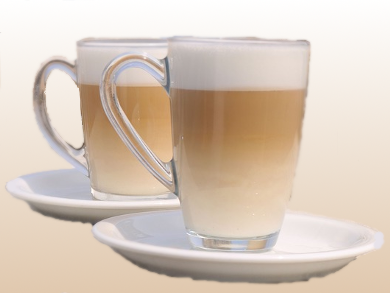A latte macchiato has several distinct layers, clearly distinguished by color, each with different espresso concentrations. This effect is called layering. Nan Xue, Princeton University, NJ, USA, and colleagues have studied layering more closely. They simulated the production of latte macchiato under controlled conditions in the laboratory with hot dyed water and a warm salt water solution.
To produce a latte macchiato, hot espresso is poured into warm milk. Since the espresso has a lower density than milk at these temperatures, it initially accumulates in the upper area of the glass. At the border between milk and coffee, the liquids mix. In addition, the molecules on the glass wall rapidly cool, become denser and sink down. As a result, a circular circulation or convection is initiated: Cold liquid flows down at the edge of the glass. In the middle of the glass, the warm liquid moves upwards. It is then pushed to the edge by the down-flowing liquid. Here it cools down, sinks down, and so on.
At the same time, the concentration gradient of the dissolved ingredients, for example, the coffee powder, has an effect on this process. Because there is less espresso mixed with the milk in the lower part of the glass, consequently there are fewer particles dissolved in the liquid, the density in this area is reduced. As a result, the sinking of the liquids is slowed down. There are different convection zones in which the concentration of the espresso decreases from top to bottom.
As the movement is driven by two factors, namely temperature and concentration gradients, it is called double-diffusive convection. To create a latte macchiato, also the pouring speed is important: Only when high enough, at least 21 m/s, the espresso and milk mix in a way that a corresponding concentration gradient arises and develops layers.
This finding may not only be of interest to physically interested coffee lovers but may also be used to produce layered structures in soft materials where the local elastic properties vary step-wise along the length of the material.
- Laboratory layered latte,
Nan Xue, Sepideh Khodaparast, Lailai Zhu, Janine K. Nunes, Hyoungsoo Kim, Howard A. Stone,
Nature Communic. 2017.
https://doi.org/10.1038/s41467-017-01852-2




